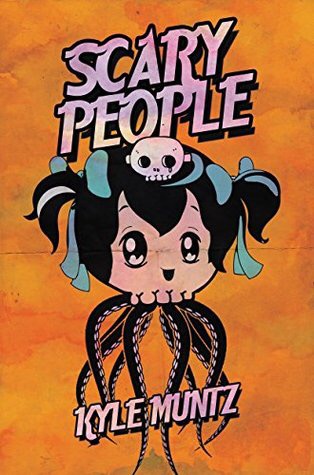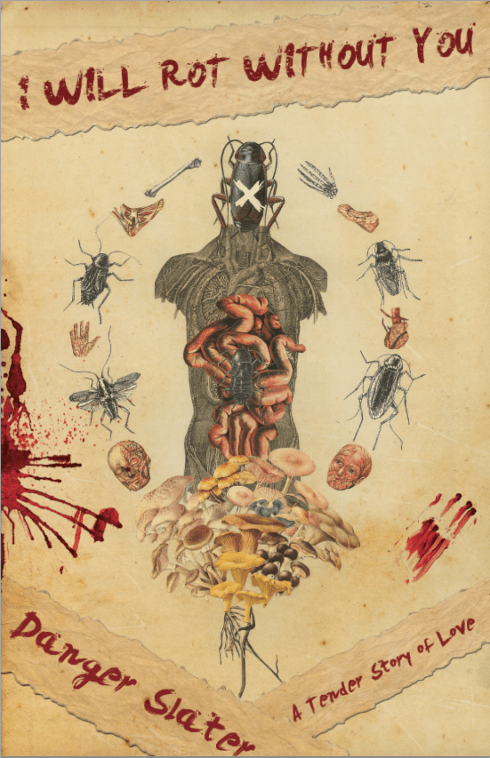I must preface this review by saying I have not yet read Aeon, the first book in a series that continues with this book: Gorgonaeon.
Part 1:
Below are some notes I wrote for each of the first 26 pages (figures) of this disjointed but magical work of art:
Figure 1:
Decapitated heads are found on the dining room table–although it is phrased as if the 2nd person protagonist usually goes to the basement rather than the dining room. There is a first person interjection of: “You wait for me to come home. But I will never come home.” An abstract charcoal illustration of a vaguely human form is printed on the opposite page.
Where are we? This short, deceptively simple paragraph that is the first section of Gorgonaeon in its entirety, hooked me immediately.
Figure 2:
The “I” is outside gazing at a broken mirror lying beneath a ladder leaning against a house that has been uninhabited for years.
Figure 3:
We are introduced to a distracted Phillip who focuses on a shiny piece of metal on a podium during a lecture. The words from the lecture become a series of sounds he calls “memory-speech”; he transcribes them until his pencil breaks.
Figure 4:
In the year “198X”, Phillip receives a letter from a friend congratulating him on a new position and inviting him to a gathering for poets.
Figure 5:
The “I” reflects on his arrangement with his lover while looking at a picture in her purse of him taken when he was more attractive.
Figure 6:
The “you” finds a plastic bag filled with snakes near the highway.
Figure 7:
“You” listens to audio cassettes of recorded monologues about a decaying garden from her “predecessor.” This “you” is for the first time identified as a she; it is also revealed that she prefers to observe rather than participate.
Figure 8:
The “I” says she has a husband. She also photographs non-chain motels and arranges the results “in a sort of geo-architectural reproduction of the highway motels.”
Figure 9:
Phillip floats through a garden, feeling so either from pills or the flower stems he has ingested. He sees a woman’s face in the moon.
Figure 10:
In an accusatory tone, the “I” interrogates the “you” about the desire to imbibe the residue of the “I”‘s mother.
I adore the line “It pains me to acknowledge your pleasure” in this section.
Figure 11:
The “I” observes and draws a beautiful girl in a coffee shop, wondering if she’s being creepy.
Figure 12:
Phillip begins taking pills at his wife’s recommendation only to have an odd vision of a man that is not him “in a wilderness of mirrors” where “green lights reflect off every surface” and he sees “only snakes.”
Figure 13:
A ditch is described where toy snakes are often found; this was also, coincidentally, the same ditch where a murdered woman’s (Nicole Logla) body was found.
Figure 14:
The “you” has entered the “I”‘s house; the “you” is betrayed for seeking answers that will never transpire.
Figure 15:
Phillip gives a semi-successful reading from his book: A Complete History of Industrial Parks–the title and subject matter of his book is related to his job.
Figure 16:
The “I” examines Polaroids of horrified, close-up faces found in the closet of her motel room.
Figure 17:
The “I” appears to be addressing the “you” as her child. She asks her child to “embrace me in the presences of She Who Stares” and states her child will be buried tomorrow.
Figure 18:
Describes a man watching television in a motel wishing to be “the mythological motel man.”
Figure 19:
The “I” states she has a “wooden visage” and now that she will be buried tomorrow.
Figure 20:
A creepy scene: Philip is lured into the motel room where he finds a sacrificed body which disappears into “the glassy walls of the motel room.”
Figure 21:
A “man” notes that the shards of glass he picks up will help him make a 24-hour film about “ugliness in the form of doomed reflections.” It is then stated that “you” will “crawl out of the earth tomorrow.”
Figure 22:
A “herald’s message” requires a new brain to be deciphered.
This was the first section that I had difficulty examining.
Figure 23:
Philip cuts his lip and fills a doll’s face with blood as “a deep red offering.”
Figure 24:
The “I” becomes a “scrivener of lurid rituals.”
Figure 25:
Phillip hears a “brutal account of his mother’s death” and is then able to learn about “the unsolved murders of the other women.”
Figure 26:
Snakes are seen as “heralds” as the mind of the “I” disintegrates and she voices a nihilistic yet creative outlook: ex. “I am the builder with no tools.”
Part 2:
Having pinned certain skeletal ideas of the first 26 pages to the screen segments above in the form of notes, analysis, and synopses, I’m going to let the rest of the work roll over me and jot down a few musings as I go.
The shifts in time and perspective give the building of this book’s reality a kind of rippling effect.
As I plunge onward, I believe at least more than one character is also using the “I” at various points. Am I wrong?
Phillip’s coin-playing reminds me of the stone-fondling scene in Samuel Beckett’s Molloy.
The image of a man dressed in armor made of crocodile skin startled me.
I have to quote page 56 in its entirety. It contains an unspeakably haunting vision of a dimension so hellish it would make even Clive Barker’s skin crawl:
“The arena is located in the middle of an industrial park. Lord Patchogue, the emperor-god incarnate, taunts the dwarves and the drooling freaks who view him as the epitome of power, pride, and sheer violence of will. Above the arena, the gossamer floats: a parachute of bloody desire of the creature-gods, the incantations spit out by the worshippers, eating their own skin, cooking it into their bread, spinning visions of unveilings. They slither through the air and through the earth until the asphalt cracks. The offices are infested with pests. There is no hiding from Lord Patchogue.”
A truly sublime and frightening passage that vividly paints a surreal nightmare.
When the “dreadful infant” is born a few pages later, I thought of Lovecraft’s moments of horrific unveiling.
The idea of highways and hallways consuming suicides is a fascinating one.
This may be the ultimate vision of loneliness:
“Do I desire company so much that I am forcing some aspect of physicality into existence, a false trail of imaginary guests?”
Wow. That was an enjoyable, transfixing, and puzzling read!
The lack of traditional narrative structure will frustrate many readers; I, on the other hand, was thrilled by it.
I felt as if the pieces to the puzzle were coming together as my brain connected several dots, but which were then, in the end, left unravelling in the darkness of glowing eyes and crocodile-skin armor as the mirror shards reflected a summoned spirit.
I will return to this volume after I have read Aeon. I sincerely hope Jordan Krall finishes this ambitious and original cycle.











